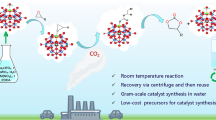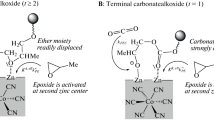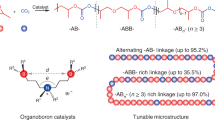Abstract
Zn3 [Co(CN)6]2 based double metal cyanide complex(Co-Zn DMC) is synthesized and characterized by element analysis, FT-IR, TG-FTIR, XRD and TEM. The composition of Co-Zn DMC summarized by elemental analysis has been confirmed by TG-FTIR. The catalyst has high crystallinity according to strong crystalline peaks shown in XRD and diffraction spot observed by TEM. Copolymerization of epoxides and carbon dioxide are successfully catalyzed by Co-Zn DMC. The efficiency of catalysts is as high as 7488 g polymer/g catalyst for CO2/propylene oxide (PO), 1100 g polymer/g catalyst for CO2/ethylene oxide (EO), which are higher than that reported ever before. The effects of various reaction conditions such as amount of the catalyst, reaction time and temperature on the copolymerization are investigated. The results show that insertion of CO2 into chains is significantly affected by the catalyst quantity and ambient temperature. The weight percentage of byproduct cyclic carbonate can be easily controlled to be less than 5% while the molar fraction of CO2 in backbone (fco2) is more than 30%.
Similar content being viewed by others
Explore related subjects
Discover the latest articles, news and stories from top researchers in related subjects.Avoid common mistakes on your manuscript.
Introduction
The utilization of carbon dioxide in the copolymerization with epoxides to afford polycarbonates has received much attention since the innovative work by Inoue et al. [1, 2]. Significant progress has been made within past decades [3–5]. Compared with other catalysts, such as rare earth catalyst [6] and salen chromium chloride/DMAP [7], double metal cyanide complex (DMC) has offered significant advantage for the alternating copolymerization of epoxides and CO2 [8–14]. And most current research focused not only on their high activities, but also on their well-defined structures that allow mechanistic investigations.
Various DMC catalysts have been utilized successfully and both of them exhibited relatively high catalytic activity under mild reaction conditions. DMC prepared by tert-butylalcohol as electron-donating complexing agent, had also been used for copolymerization of PO and CO2, and it could demonstrate catalytic activity at 2300 g polymer/g catalyst [15]. Besides a variety of transition metal elements such as Ni, Co, Fe, Mn have also been studied. DMC catalysts based on Zn3[Co(CN)6]2 have been identified most active for the copolymerization of epoxides and CO2. Huang [16] prepared a group of catalysts with different morphology and composition. It was reported that the catalyst was more active when it had low crystallinity. Kim [10] synthesized a variety of catalysts with low crystallinity using ZnX2(X = F, Cl, Br, I) and the results showed lower crystallinity was in favor of the catalytic activity too. In our previous work [17, 18] the PBM (polymer supported bimetallic cyanide, a kind of DMC), which was amorphous, also showed the good activity in copolymerization of CO2 and epoxides.
In this paper, a type of active DMC catalyst based on Zn3[Co(CN)6]2 is prepared with efficiency as high as 7488 g copolymer per catalyst for CO2/PO. In the study of TEM and XRD we identify high crystallinity of this active catalyst which is very different from previous conclusions [10, 16–21], which is highly crystalline compound acts either as a diluent or as a poison for the most active amorphous form of the catalyst. For our study the crystalline status is not a decisive factor on the catalytic activity.
Materials and methods
Materials
Potassium hexacyanocobatate(III) (K3Co(CN)6) is purchased from Acros. Zinc chloride (ZnCl2) and tert-butyl alcohol (tBuOH) are at analytical grade and used without further purification. Propylene oxide (PO) was refluxed over calcium hydride (CaH2),then distilled and stored over CaH2. Ethylene oxide (at −5 °C or below) was stored over Linde type 3 Å molecular sieve. CO2 (>99.9%) was used without further purification.
Preparations of DMC catalysts
Under vigorous stirring, K3Co(CN)6 (3.32 g, 0.01 mol) is dissolved in distilled water (50 mL) as solution 1 (0.2 mol·L−1). ZnCl2 (40 g) is dissolved in mixture of distilled water (150 mL) and tBuOH (75 mL) as solution 2. Under vigorous mechanical stirring, solution 2 is added dropwise into solution 1 over 40 min at 40 °C. The mixture is stirred vigorously for another 2 h and then it is centrifuged. The precipitate is washed several times with gradually increasing portion of tBuOH against water. The solid is resuspended in tBuOH with 2 h stirring to exclude water. Subsequently the solid is centrifuged. At last, the catalyst cake is dried at 45 °C under vacuum till constant weight. Our catalyst is of high crystallinity, which is diverse with previous results.
Copolymerization of CO2 and the epoxides
Copolymerization is performed in a 130 ml autoclave equipped with magnetic stirring and pressure indicator. Prior to the experiment, the autoclave is heated to 100 °C for 1 h, desired amount of catalyst and PO/EO are added, heated to reaction temperature, then autoclavea is filled by CO2 to proper pressure. After desired time, it is cooled down and pressure is slowly released.
Characterizations
The crystallinity of the catalysts is estimated by a D/Max-IIIA Powder X-ray Diffractometer. The chemical composition of catalysts is analyzed by a Vario EL CHNS Elemental Analyzer and Hitachi Z-5000 atomic absorption spectrophotometer. Infrared spectra are measured using an Analect RFX-65A FT-IR spectrophotometer. Thermo gravimetric analysis/infrared spectra are performed by TG-209/Vector TM -22 under a protective nitrogen atmosphere. The heating rate employed is 10 °C min−1. The morphology of the catalysts is observed by transmission electron microscopy (TEM) (JEM-100CX α, Japan). The composition of the copolymer is measured by 1H NMR (DRX-400, 400 MHz) using CDCl3 as solvent. The molecular weight and distribution of copolymers are determined by gel permeation chromatography (GPC) using THF (PPC) or DMF (PEC) as a solvent with a Waters 515–410 machine.
Results and discussion
Catalyst characterization
Elemental analysis (EA)
The preparation of Co-Zn DMC is carried out via the reaction of K3[Co(CN)6] and ZnCl2. This reaction may lead to the precipitate of Zn3[Co(CN)6]2. The trace amount of potassium ion has been revealed harmful to catalytic activity in ROP of epoxides. It sometimes makes the catalysis inactive. Therefore, potassium ion should be extracted repeatedly by tBuOH-water mixture with gradually increasing portion of tBuOH. Elemental analysis (see Table 1) indicates that the catalyst contained tBuOH, ZnCl2 and H2O. Empirical formulas of catalyst could be expressed as 2.82Zn·0.49Cl·[Co(CN)7.38]·1.32C4H10O·0.04H2O·2.27OH. The content of K+ is less than 100 ppm.
FT-IR
The IR spectrum of Co-Zn DMC (see Fig. 1) shows the absorption peak of different CN group. The absorption peak of CN−1 in DMC is at 2194.6 cm−1 when free CN−1 is at 2080 cm−1 and CN−1 of K3Co(CN)6 is at 2133.4 cm−1 . It is reported that CN−1 of K3Co(CN)6 moved comparing with free CN−1 due to its electronic donation to Co ion [22]. The absorption of CN−1 in DMC moved more greatly than that of CN−1 in K3Co(CN)6 because possibly CN−1 in DMC not only donate electrons to Co, but also coordinate with Zn ion.
TG-FTIR
Figure 2 shows the FTIR spectrum of gaseous mixtures at decomposition of Co-Zn DMC in nitrogen at certain temperature which symbol different decomposition procedure. In Fig. 2, the coordination characteristic absorption peaks are detected as: 2278 cm−1 (C-N stretching), 2932 cm−1 (C-H stretching), and 3256 cm−1 (O-H stretching). During its decomposition procedure from 20 °C to 800 °C and under a heating rate of 10 °C min−1, TG and DTG curves of the Co-Zn DMC had been recorded as Fig. 3. According to Fig. 3 there would be four decomposition steps, which were also indicated in Table 2.
As presented in Table 2, the catalyst is rather stable below 188 °C. It indicates no real decomposition happen at low temperature. The release of free or adsorption of H2O and little tBuOH contributed to the 7.9% weights lose. The evidence of weak OH stretching from H2O and CH stretching from tBuOH could be found in Fig. 2a. The following step is removal of coordinated H2O and tBuOH till 367 °C. Compared with that in Fig. 2a, stronger OH and CH stetching could be found in Fig. 2b and c. All together 18.8% weights lose indicates all H2O and tBuOH entered into gas mixtures. From 368 to 650 °C is the third decomposition step in which inorganic portion of Co-Zn DMC decompose completely and much HCN is observed in gas mixture (strong C-N stretching at 2278cm−1 in Fig. 2d). The residue after 650 °C is up to 49.7%, which has been identified as ZnO and Co2O3 by FTIR.
XRD
The crystal structure is investigated by X-ray diffraction (see Fig. 4). The crystallinity of Co-Zn DMC,which is more than 75%, could be calculated by the ratio of area of crystalline peaks and totally area including crystalline and broad amorphous peaks.
It was reported that the DMC catalysts with lower crystallinity are more active for the homo- and copolymerization of epoxides and CO2 [10, 16–21], and the DMC exhibited high catalytic activity only when the crystallinity degree was ≤30%. Our results show significant difference.
TEM
The Transmission electron microscopy (TEM) image of the catalysts is given in Fig. 5, and strong polycrystalline diffraction spots was observed. It is clear that Co-Zn DMC particles were a polycrystalline structure rather than amorphous morphology.
Analysis of polycarbonate
The resulted copolymers are characterized by FT-IR and 1H-NMR spectroscopy. Absorption peak at 1744cm−1 corresponds to C = O stretching vibration of the copolymer, which indicates formation of carbonate in backbone of polymers. Meanwhile, the peaks at 1806 cm−1 and 777 cm−1 belong to characteristic peaks of cyclic carbonate. 1H-NMR spectrum in Fig. 6 also confirms existence of carbonate linkages in the resulting copolymer (see Scheme 1): 5.0[1H, CH(a)], 3.5[2H, CH2(e)] 4.2[2H, CH2(b)], 1.34[3H, CH3(c)]. Moreover cyclic carbonate formed as byproduct: 4.89[1H, CH(h)], 4.58[1H, CH(i)], 4.04[1H, CH(j)], 1.50[3H, CH3(g)].
All the proton peaks are marked in Fig. 6. According to integrations of chemical shifts for CH (a), CH3 (c) and CH3 (f) in the copolymer, the mole of CO2 incorporated in copolymer is calculated as equation Scheme 2 [15]:
The copolymerization of EO with CO2 is carried out in the presence of DMC catalyst, as shown in Scheme 3. The m in the scheme represents the carbonate content, WEC represent content of cyclic carbonate. Both of them could be calculated according to the Scheme 4. Proton peaks in the 1H NMR spectrum (see Fig. 7) indicates existence of carbonate linkage: 4.2[2H, CH2(b)], 3.6[2H, CH2(a)], cyclic carbonate 4.5[2H, CH2(d)].
Copolymerization of epoxides and CO2
The copolymerization of PO or EO with CO2 is performed based on DMC catalyst as shown in Scheme 5. And the copolymers are characterized below.
Copolymerization of PO with CO2
Table 3 summarizes the copolymerization of PO with CO2 in the presence of Co-Zn DMC catalyst. As shown in Table 3, by changing the catalyst amount from 3 mg to 20 mg, catalytic efficiency varied significantly from 1100 g polymer/g catalyst to 7488 g polymer/g catalyst. When the catalyst amount is 1 mg or temperature is 60 °C, no reaction was observed. Maybe the few active centers were influenced significantly by trace of water, alcohol and other impurities under low catalyst concentration. It seems higher catalytic concentration decreased catalytic efficiency rather than molecular weight. Due to the chain transfer the molecular weight are no more than 50,000 and PDI are always around 3 even if catalyst concentration was decreased to 3 mg. The initiation of copolymerization would benefit from elevated temperature. Polymer/g catalyst reaches the highest catalytic efficiency of 7488 g polymer/g catalyst at 100 °C using 3 mg Co-Zn DMC, which is higher than previous report [15]. As shown in Table 3, when the amounts of DMC employed increased from 3 mg to 10 mg,the fCO2 increased from 30.7% to 38.5%. Further increasing the amounts of DMC up to 20 mg resulted in a slight decrease in the molar ratio of CO2 (fco2) in backbones.
Copolymerization of EO with CO2
The copolymerization of EO with CO2 is also carried out at varied temperatures with fixed catalyst concentration and the pressure of CO2, as shown in Table 4. It is observed that by changing the temperature from 60 to 90 °C the catalytic activity increases from 38 to 945 g polymer/g catalyst while the molar fraction of CO2 in backbone decreased from 33.3% to 22.1%. Ethylene carbonate is also produced as a byproduct. Its yield is affected greatly by reaction temperature. When a suitable temperature such as 70 °C was chosen, the weight percentage of ethylene carbonate can be controlled to as little as 3.4%. Meanwhile higher temperature benefits homo-polymerization more than copolymerization, resulting in decrease of molar fraction of CO2 in backbone. Reaction time only affects molar fraction of CO2 slightly. Therefore molar fraction of CO2 in backbone almost keeps 32% while reaction time varied from 12 h to 36 h. The molecular weight would increases greatly by increasing temperature and elongating reaction time. The copolymer with fco2 of 31.4% and molecular weight of 107,000 is obtained in a 36 h run at 70 °C, which catalytic efficiency arrive 1100 g polymer/g catalyst.
Conclusion
In this study, Co-Zn DMC has been synthesized and characterized by elemental analysis, TG-FTIR, XRD and TEM. The crystalline structure of catalyst is proved as high as 75%, which is different from previous work. It exhibits very high catalytic activity in copolymerization of CO2 and PO or EO. A polycarbonate with a small portion of polyether linkage is obtained. 1100 g polymer/g catalyst for CO2/EO, 7488 g copolymer for CO2/PO were obtained with lower byproduct weight percent(<5%) and higher molar fraction of CO2 (fco2 >30%)in backbone, which was higher than any previous reports.
This promising result is guiding us to investigate the DMC catalysts in more detail.
References
Inoue S, Koinuma H, Tsuruta T (1969) Polymer letter 7:287–292
Inoue S, Yokoo Y (1972) J Organomet Chem 39:11
Qin YS, Wang XH (2010) Biotechnology journal 5:1164–1180
Darensbourg DJ, Holtcamp MW (1996) Coordination Chemistry Reviews 153:155
Wu GP, Lu XB, Darensbourg DJ et al (2010) Macromolecular 43:4302
Chen XH, Shen ZQ, Zhang YF (1991) Macromolecules 24(19):5305
Darensbourg DJ, Yarbrough JC (2002) J Am Chem Soc 124:6335
Kruper WJ, Swart DJ (1985) US Patent 4500704
Mullica DF, Milligan WO, Beall GW (1978) Acta Crystallogr B34:3558
Kim I, Min JY, Kyoung JL, et al (2006) Catalysis Today: 292–296
Min JY, Seung HB, Ha CS et al (2004) Solid State Ionics 172:139–144
Kim I, Min JY, Seung HB et al (2005) Macromol. Symp 224:181–191
Kim I, Lee IK, Ha JY, Ha CS (2009) Catal. Today 148:389–397
Chen S, Qi GR, Hua ZJ et al (2004) J Polym Sci Pol Chem 42(20):5284–5291
Chen S, Hu ZJ, Fang Z et al (2004) Polymer 45:6519–6524
Huang YJ, Qi GR, Chen LS (2003) Applied Catalysis A: General 240:263–271
Chen LB (1992) Makromol Chem Macromol Symp 59:75–82
Chen LB, Huang B, Zhao J (1994) J Nat Gas Chem 4:368–378
Min JY, Seung HB, Ha CS et al (2004) Solid State Ionics 172:139–144
Dharman MM, Ahn JT, Lee MK et al (2008) ResChemIntermed 34:835–844
Zhang XH, Liu F, Sun XK et al (2008) Macromolecules 41:1587–1590
Kim I, Ahn JT, Ha CS et al (2003) Polymer 44:3417–3428
Acknowledgements
This project was supported by the Natural Science Foundation of Guangdong province, China (9151065004000005).
Author information
Authors and Affiliations
Corresponding author
Rights and permissions
About this article
Cite this article
Zhou, T., Zou, Z., Gan, J. et al. Copolymerization of epoxides and carbon dioxide by using double metal cyanide complex (DMC) with high crystallinity. J Polym Res 18, 2071–2076 (2011). https://doi.org/10.1007/s10965-011-9616-4
Received:
Accepted:
Published:
Issue Date:
DOI: https://doi.org/10.1007/s10965-011-9616-4
















